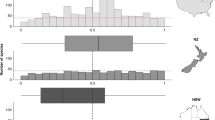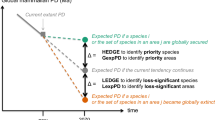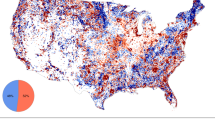Abstract
There is contentious debate surrounding the merits of de-extinction as a biodiversity conservation tool. Here, we use extant analogues to predict conservation actions for potential de-extinction candidate species from New Zealand and the Australian state of New South Wales, and use a prioritization protocol to predict the impacts of reintroducing and maintaining populations of these species on conservation of extant threatened species. Even using the optimistic assumptions that resurrection of species is externally sponsored, and that actions for resurrected species can share costs with extant analogue species, public funding for conservation of resurrected species would lead to fewer extant species that could be conserved, suggesting net biodiversity loss. If full costs of establishment and maintenance for resurrected species populations were publicly funded, there could be substantial sacrifices in extant species conservation. If conservation of resurrected species populations could be fully externally sponsored, there could be benefits to extant threatened species. However, such benefits would be outweighed by opportunity costs, assuming such discretionary money could directly fund conservation of extant species. Potential sacrifices in conservation of extant species should be a crucial consideration in deciding whether to invest in de-extinction or focus our efforts on extant species.
This is a preview of subscription content, access via your institution
Access options
Access Nature and 54 other Nature Portfolio journals
Get Nature+, our best-value online-access subscription
$29.99 / 30 days
cancel any time
Subscribe to this journal
Receive 12 digital issues and online access to articles
$119.00 per year
only $9.92 per issue
Buy this article
- Purchase on Springer Link
- Instant access to full article PDF
Prices may be subject to local taxes which are calculated during checkout

Similar content being viewed by others
References
Folch, J. et al. First birth of an animal from an extinct subspecies (Capra pyrenaica pyrenaica) by cloning. Theriogenology 71, 1026–1034 (2009).
Callaway, E. Stem-cell plan aims to bring rhino back from brink of extinction. Nature 533, 20–21 (2016).
Kumar, S. Extinction need not be forever. Nature 492, 9 (2012).
Sherkow, J. S. & Greely, H. T. What if extinction is not forever? Science 340, 32–33 (2013).
Cohen, S. The ethics of de-extinction. NanoEthics 8, 165–178 (2014).
Shapiro, B. Mammoth 2.0: Will genome engineering resurrect extinct species? Genome Biol. 16, 228 (2015).
Seddon, P. J., Moehrenschlager, A. & Ewen, J. Reintroducing resurrected species: selecting DeExtinction candidates. Trends Ecol. Evol. 29, 140–147 (2014).
Jones, K. E. From dinosaurs to dodos: Who could and should we de-extinct? Front. Biogeog. 6, 20–24 (2014).
Weeks, A. R. et al. Assessing the benefits and risks of translocations in changing environments: a genetic perspective. Evol. Appl. 4, 709–725 (2011).
Jenkins, C. N., Van Houtan, K. S., Pimm, S. L. & Sexton, J. O. US protected lands mismatch biodiversity priorities. Proc. Natl Acad. Sci. USA 112, 5081–5086 (2015).
Peers, M. J. L. et al. De-extinction potential under climate change: extensive mismatch between historic and future habitat suitability for three candidate birds. Biol. Cons. 197, 164–170 (2016).
IUCN/SSC Guiding Principles on Creating Proxies of Extinct Species for Conservation Benefit: Version 1.0 (International Union for Conservation of Nature, 2016).
Camacho, A. E. Going the way of the dodo: de-extinction, dualisms, and reframing conservation. Wash. Univ. Law Rev. 92, 849–906 (2015).
Shapiro, B. Pathways to de-extinction: How close can we get to resurrection of an extinct species? Funct. Ecol. http://dx.doi.org/10.1111/1365-2435.12705 (2016).
Bennett, J. R. et al. Balancing phylogenetic diversity and species numbers in conservation prioritization, using a case study of threatened species in New Zealand. Biol. Cons. 174, 47–54 (2014).
Tulloch, A. I. T. et al. Effect of risk aversion on prioritizing conservation projects. Cons. Biol. 29, 513–524 (2015).
More Plants and Animals to be Saved from Extinction: Saving Our Species 2016–2021 (New South Wales Office of Environment and Heritiage, 2016).
Wood, J. R. et al. Resolving lost herbivore community structure using coprolites of four sympatric moa species (Aves: Dinornithiformes). Proc. Natl Acad. Sci. USA 110, 16910–16915 (2013).
McCauley, D. J., Hardesty-Moore, M., Halpern, B. S. & Young, H. S. A mammoth undertaking: harnessing insight from functional ecology to shape de-extinction priority setting. Funct. Ecol. http://dx.doi.org/10.1111/1365-2435.12728 (2016).
Minteer, B. A. Is it right to reverse extinction? Nature 509, 261 (2014).
Nogués-Bravo, D., Simberloff, D., Rahbek, C. & Sanders, N. J. Rewilding is the new Pandora’s box in conservation. Curr. Biol. 26, R87–R91 (2016).
Restani, M. & Marzluff, J. M. Funding extinction? Biological needs and political Realities in the allocation of resources to endangered species recovery. BioSci. 52, 169–177 (2002).
Martín-López, B., Montes, C., Ramírez, L. & Benayas, J. What drives policy decision-making related to species conservation? Biol. Cons. 142, 1370–1380 (2009).
McCarthy, D. P. et al. Financial costs of meeting global biodiversity conservation targets: current spending and unmet needs. Science 338, 946–949 (2012).
Wilson, K. A., Carwardine, J. & Possingham, H. P. Setting conservation priorities. Ann. NY Acad. Sci. 1162, 237–264 (2009).
Joseph, L. N., Maloney, R. F. & Possingham, H. P. Optimal allocation of resources among threatened species: a project prioritization protocol. Cons. Biol. 23, 328–338 (2009).
Acknowledgements
J.R.B. was supported the Natural Science and Engineering Research Council of Canada (NSERC) and the Australian Research Council (ARC) Centre of Excellence for Environmental Decisions (CEED). H.P.P. was funded by an ARC Laureate Fellowship and CEED.
Author information
Authors and Affiliations
Contributions
J.R.B., R.F.M. and P.J.S. designed the study. J.R.B., R.F.M. and J.B.-B. analysed the data. J.R.B. wrote the paper, with input from all other authors.
Corresponding author
Ethics declarations
Competing interests
The authors declare no competing financial interests.
Supplementary information
Supplementary information
Supplementary Tables 1,2; Supplementary Discussion (PDF 310 kb)
Rights and permissions
About this article
Cite this article
Bennett, J., Maloney, R., Steeves, T. et al. Spending limited resources on de-extinction could lead to net biodiversity loss. Nat Ecol Evol 1, 0053 (2017). https://doi.org/10.1038/s41559-016-0053
Received:
Accepted:
Published:
DOI: https://doi.org/10.1038/s41559-016-0053
This article is cited by
-
Economic growth, government efficiency, and biodiversity loss: an international trade perspective
Environment, Development and Sustainability (2023)
-
Half of resources in threatened species conservation plans are allocated to research and monitoring
Nature Communications (2020)
-
Why Wake the Dead? Identity and De-extinction
Journal of Agricultural and Environmental Ethics (2020)
-
Won’t Somebody Please Think of the Mammoths? De-extinction and Animal Welfare
Journal of Agricultural and Environmental Ethics (2018)
-
De-extinction needs consultation
Nature Ecology & Evolution (2017)



